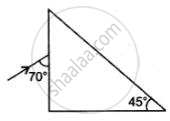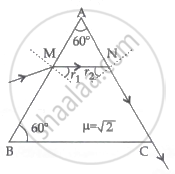Advertisements
Advertisements
Question
Why do diamonds sparkle?
Solution
Critical angle for diamond is quite less and is only 24°. Besides these diamonds are cut very sharp, making a large number of the refracting surfaces. Hence when a ray of light enters a diamond, it suffers a series of total internal reflections on account of a very small critical angle. This makes a ray of light literally trapped within the diamond for a little time and this trapped light energy makes a diamond sparkle.
APPEARS IN
RELATED QUESTIONS
Which colour of light has a higher critical angle? Red light or green light.
(i) Define critical angle.
(ii) State one important factor which affects the critical angle of a given medium.
In the following figure, show two rays A and B travelling from water to air. If the critical angle for water- air surface is 48°, complete the ray diagram showing the refracted rays for each. State conditions when the ray will suffer total internal reflection.

Can light be ‘piped’ like sound in a doctor’s stethoscope?
Draw a diagram, properly labelled, to illustrate the use of a total reflecting prism (a right-angled isosceles prism) to turn a ray of light through 180°. Name an instrument in which this device is used.
Complete the following diagram to show the path of the ray of a single colour in the diagram as if enters in and emerges out of the prism. Mark the angles wherever necessary. (Critical angle for glass = 42°).

Answer the following question.
Under what conditions are total internal reflection possible? Explain it with a suitable example.
What are the examples of total internal reflection in nature?
A ray of light passes through a prism of refractive index `sqrt2` as shown in the figure. Find:

- The angle of incidence (∠r2) at face AC.
- The angle of minimum deviation for this prism.
State two differences between normal reflection and total internal reflection.
